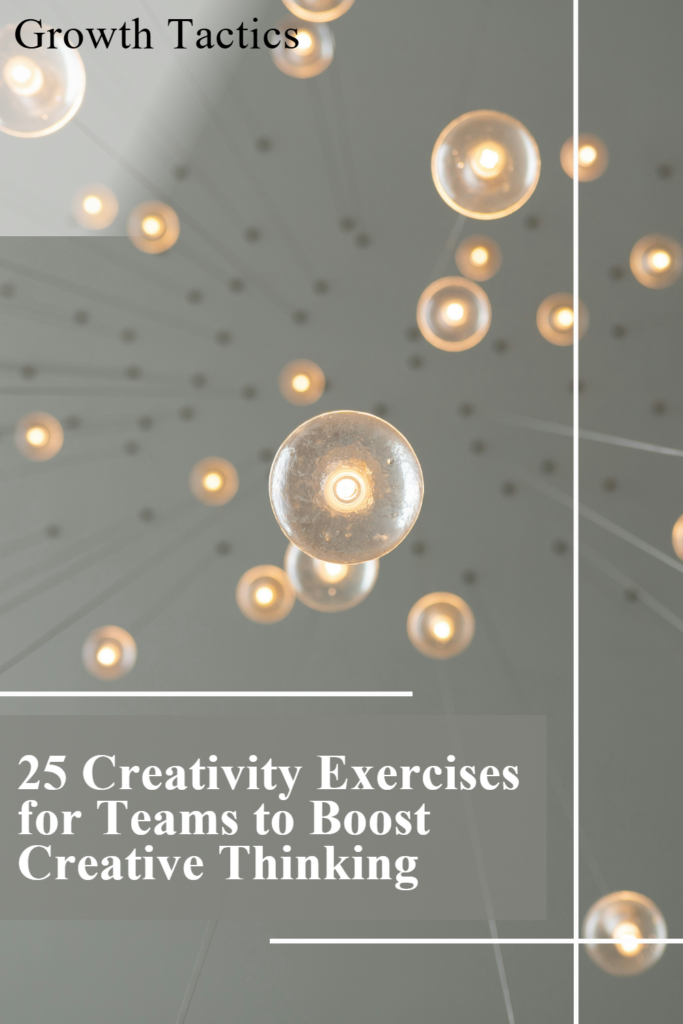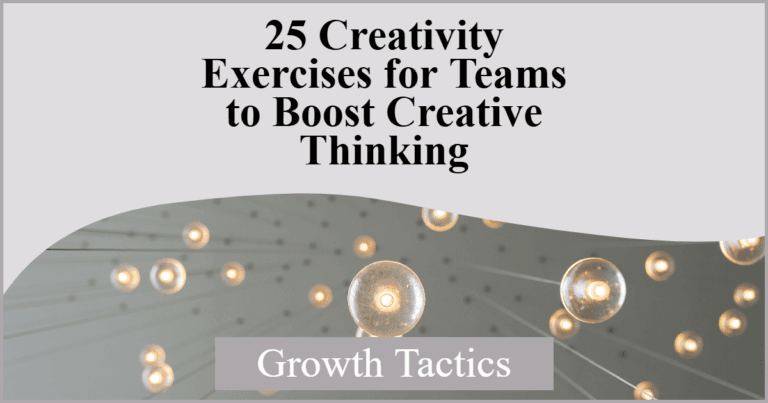Have you ever felt like your team’s creativity well has run dry? I’ve been there, and it’s not a fun place to be. But here’s the good news: creativity isn’t some magical gift that only a few lucky people have. It’s a skill we can all develop and strengthen, just like a muscle. That’s why I’m excited to share these 25 creativity exercises for teams.
Jump To Section
Effective Creativity Exercises for Teams
Alright, let’s dive into some creativity exercises that I’ve found incredibly helpful for teams. I’ve used many of these myself, and I can tell you firsthand that they really work. Here’s a list of 25 exercises to get those creative juices flowing:
1. Reverse Brainstorming
This is one of my favorites. Instead of asking, “How can we solve this problem?”, flip it on its head. Ask, “How can we make this problem worse?” It sounds crazy, but trust me, it works.
Here’s how to do it:
- State your problem clearly.
- Ask everyone to think of ways to make the problem worse.
- List all these “worst” ideas.
- Now, take each bad idea and flip it to find good solutions.
2. Six Thinking Hats
This exercise helps you look at a problem from different angles. It’s like trying on different hats for your brain.
Here’s how it works:
- Assign each team member a colored hat:
- White: Facts and information
- Red: Emotions and feelings
- Black: Potential problems
- Yellow: Benefits and positives
- Green: Creativity and new ideas
- Blue: Process and overview
- Each person thinks about the problem from their hat’s perspective.
- Share ideas and discuss.
I love this because it helps quieter team members speak up and prevents one viewpoint from dominating.
3. Random Word Association
This exercise is all about making unexpected connections. It’s helped me break out of mental ruts many times.
How to do it:
- Pick a random word (use a dictionary, word generator, or point to a random object).
- List attributes of this word.
- Force connections between these attributes and your problem.
- See what new ideas emerge.
4. Mind Mapping
This is a great visual tool that helps you see connections between ideas. I use it all the time for personal projects too.
Steps:
- Write your main idea or problem in the center of a blank page.
- Draw branches off this center, each with a related idea.
- Keep branching out with more related thoughts.
- Look for connections between branches.
5. SCAMPER
SCAMPER is an acronym that helps you think about changing parts of your problem or solution. Each letter stands for a different way to tweak your ideas.
Here’s how to use it:
- Substitute: What can you swap out?
- Combine: What ideas can you merge?
- Adapt: How can you adjust for a new use?
- Modify: Can you change the shape, look, or feel?
- Put to another use: Can you use this somewhere else?
- Eliminate: What can you remove?
- Reverse: Can you do the opposite?
Go through each step and see what new ideas pop up.
6. The 30 Circles Test
This is a quick, fun exercise that gets your creative juices flowing fast.
Here’s what to do:
- Give everyone a sheet with 30 blank circles.
- Set a timer for 3 minutes.
- Ask everyone to turn as many circles as they can into recognizable objects.
- Compare results and discuss.
It’s not about artistic skill, it’s about quick, creative thinking.
7. Forced Connections
This exercise helps you make unexpected links. I’ve had some of my best ideas using this method.
How it works:
- Pick your problem or challenge.
- Choose a random object or idea (the more unrelated, the better).
- Force yourself to find connections between the two.
- See what new ideas emerge from these connections.
8. Role Storming
This is like brainstorming, but with a twist. You pretend to be someone else. It can lead to some amazing insights.
Steps:
- Choose a famous person or character (like Einstein, Oprah, or Spider-Man).
- Think about your problem from their perspective.
- How would they approach it? What would they say or do?
- Share these ideas with the group.
I’ve seen shy team members really open up with this exercise. It’s amazing what happens when you step out of your own shoes for a bit.
9. The Five Whys
This is a simple but powerful tool. I use it all the time to get to the root of problems.
Here’s how to do it:
- State your problem.
- Ask “Why?” and answer.
- Take that answer and ask “Why?” again.
- Repeat five times.
For example, I once used this when my team kept missing deadlines. By the fifth “why,” we realized we needed better project management tools. It’s amazing how deep you can go with just one word!
10. Brainwriting
This is great for introverts like me who sometimes struggle in loud brainstorming sessions.
How it works:
- Give everyone a sheet of paper.
- Write down ideas silently for a few minutes.
- Pass your sheet to the person next to you.
- Build on the ideas you receive.
- Keep passing and building until everyone has seen all sheets.
I love this because it gives everyone a chance to contribute without feeling put on the spot.
11. Analogies and Metaphors
This exercise helps you see your problem in a new light. I’ve had some real “aha!” moments with this one.
Steps:
- State your problem clearly.
- Think of something completely different (like nature, sports, or cooking).
- How is your problem like this other thing?
- What solutions does this comparison suggest?
For instance, I once compared managing a team to conducting an orchestra. It led to some great insights about timing and coordination!
12. Challenge Assumptions
We all make assumptions. This exercise helps us question them and find new solutions.
Here’s how:
- List all your assumptions about the problem.
- For each one, ask “Is this really true?”
- What if the opposite were true?
- What new ideas does this spark?
I’ve used this to help teams break out of “we’ve always done it this way” thinking.
13. Worst Idea
This is similar to reverse brainstorming, and it’s a lot of fun!
How to do it:
- Come up with the worst possible solutions to your problem.
- Go wild; the worse, the better!
- Now, flip each bad idea. How could you make it good?
14. Picture Prompts
This exercise taps into your visual creativity. I use it when I’m feeling stuck.
Steps:
- Gather random images (from magazines, websites, etc.).
- Pick an image at random.
- How does this image relate to your problem?
- What ideas does it spark?
You’d be surprised how a picture of a tree or a bicycle can lead to breakthrough ideas!
15. What If
This exercise helps you think beyond current limitations. It’s all about possibilities.
How to do it:
- Start with “What if…” questions about your problem.
- Be bold, don’t worry about reality yet.
- For each “What if,” brainstorm potential solutions.
I love asking things like “What if money were no object?” or “What if we had unlimited time?” It really opens up your thinking.
16. Idea Box
This is a great way to combine different aspects of a problem or solution.
Here’s how:
- Create a grid. Columns are different aspects of your problem.
- Fill in options for each aspect.
- Randomly combine one option from each column.
- See what new ideas this sparks.
17. Storyboarding
I love this exercise because it helps visual thinkers like me express ideas clearly.
Here’s how to do it:
- Grab some paper and divide it into 6-8 boxes.
- In each box, draw a simple picture showing a step in your problem or solution.
- Add short captions if needed.
- Look at your story. Does it make sense? What’s missing?
I once used this to map out a tricky project, and it really helped my team see the big picture.
18. Alphabet Brainstorming
This is a fun way to push your brain to think differently. I use it when I’m feeling stuck.
Steps:
- Write the alphabet down on the left side of your paper.
- For each letter, think of an idea related to your problem that starts with that letter.
- Don’t worry if you can’t fill every letter. The goal is to spark new thoughts.
It’s amazing how this simple exercise can lead to ideas you might never have considered!
19. Random Acts of Kindness
This exercise reminds us that creativity can come from helping others. It always leaves me feeling inspired.
How to do it:
- Think about your community or workplace.
- List 10 small, kind things you could do for others.
- For each act, consider how it might relate to your problem.
- See what new ideas this sparks.
I once used this to solve a team morale issue, and it led to a great new recognition program.
20. Future Headlines
I love this exercise because it helps you visualize success. It’s like creating a roadmap for your goals.
Steps:
- Imagine your problem is solved perfectly.
- Write 3-5 newspaper headlines announcing this success.
- Be specific and bold!
- Look at your headlines. What steps would you need to take to make them true?
21. Constraint Addition
Sometimes, limits can spark creativity. This exercise proves that point.
Here’s how:
- State your problem.
- Add an artificial limit (like “You only have $10” or “It must fit in a shoebox”).
- Brainstorm solutions within this constraint.
- See how these ideas might apply to your real situation.
22. Fishbone Diagram
This is a great tool for understanding complex problems. I use it when I need to see all the factors at play.
Steps:
- Draw a line with an arrow pointing right. Write your problem at the arrow’s point.
- Draw diagonal lines branching off this main line.
- Label each line with a category of causes (like “People,” “Process,” “Technology”).
- Add specific causes as smaller branches off each category.
This visual approach has helped me tackle some really thorny issues by breaking them down into manageable parts.
23. Forced Analogy
This exercise pushes you to make unexpected connections. It can lead to some really creative solutions!
How to do it:
- Pick a random object (like a pencil or a tree).
- List its characteristics.
- For each characteristic, ask how it relates to your problem.
- See what new ideas this sparks.
I once compared a team conflict to a traffic jam, and it led to some great insights about communication flow!
24. Exaggeration
This is a fun way to look at problems differently. I use it when I need to shake up my thinking.
Steps:
- State your problem in an exaggerated way. Make it huge!
- Come up with equally exaggerated solutions.
- Now, scale these wild ideas back to reality.
- See what practical ideas emerge.
25. Reverse Assumptions
This is great for challenging the status quo. It’s helped me find innovative solutions many times.
Here’s how:
- List all the common assumptions about your problem or industry.
- For each one, ask “What if the opposite were true?”
- Brainstorm ideas based on these reversed assumptions.
- See which ideas might work in reality.
Remember, the key is to find what works best for your team. Don’t be afraid to tweak these exercises to fit your needs. The goal is to unlock each person’s unique creativity and solve problems in fresh ways. Give these a try and watch your team’s innovation soar!
How Can Team Building Foster Creative Thinking?
Team building isn’t just about trust falls and company picnics. It’s a powerful tool for boosting creative thinking. I’ve seen it work wonders in my own teams. When people feel connected, they’re more likely to share wild ideas without fear.
Think about it: we’re all unique. We each bring different skills and experiences to the table. Team building helps us appreciate these differences. It creates a space where we can bounce ideas off each other. This mix of perspectives often leads to creative solutions we’d never think of alone.
How Do Team Members Benefit from Collaborative Creative Exercises?
Collaborative exercises are like a gym for your creative muscles. They help team members grow in ways they might not expect. I’ve seen shy folks become confident speakers through these activities.
First, these exercises help us learn from each other. We get to see how others approach problems. This broadens our own thinking. Second, they build confidence. When your ideas are heard and valued, you’re more likely to speak up in the future.
How to Implement Creativity Training in the Workplace?
Bringing creativity training into your workplace doesn’t have to be complicated. Start with small, regular exercises. Maybe kick off each meeting with a quick creative challenge. This gets people in the right mindset.
Make it clear that creativity is valued. Reward innovative thinking, even if the ideas don’t always pan out. I once worked with a company that had an “Idea of the Month” award. It wasn’t about the best idea, but the most creative one. This really got people thinking differently.
Remember, creativity is a skill. It needs practice. Set aside time for it. Maybe have a monthly creativity workshop. Or give employees an hour each week to work on passion projects. The key is to make creativity a habit, not a one-time event.
What Are the Best Practices for Conducting a Brainstorming Session?
Brainstorming can be hit or miss. However, with the right approach, it can be a goldmine of ideas. Here’s what I’ve found works best:
- Set clear goals, but keep the atmosphere relaxed.
- Encourage wild ideas. The crazier, the better.
- Don’t judge. Save evaluation for later.
- Build on others’ ideas. Use “Yes, and…” instead of “But…”
- Take breaks. Our brains need rest to stay creative.
I once led a brainstorming session where we used sticky notes and a big wall. Everyone wrote ideas and stuck them up. Then we grouped similar ones. This visual approach helped us see connections we might have missed otherwise.
How Can You Sustain Creative Juices Flowing in Teams?
I’ve found that keeping teams creative is all about balance. Mix things up! Try brainstorming sessions one day, then switch to individual thinking time the next. In my experience, people feel more energized when they have variety in their work.
Remember, everyone’s different. Some folks love group chats, while others need quiet time to think. As a leader, I always make sure to offer both. It’s amazing how much more creative people can be when they’re working in a way that suits them best.
How to Encourage Continuous Creative Thinking at Work?
Make it fun! I love setting up little challenges or games that get people thinking outside the box. It could be as simple as asking, “How many uses can you think of for a paperclip?” These quick exercises keep minds sharp and ready for bigger creative tasks.
Also, don’t forget to celebrate ideas, even the wild ones. I always tell my team, “There’s no such thing as a bad idea during brainstorming.” This helps people feel safe to share their thoughts, no matter how out-there they might seem.
What Role Does Environment Play in Fostering Creativity?
Your workspace matters more than you might think. I’ve seen dull offices kill creativity, while bright, open spaces can make ideas flow. But it’s not just about looks. The feeling of the place is key.
Try this: add some plants, put up inspiring quotes, or create a cozy corner for thinking. I once worked in an office where we had a “crazy idea wall” where anyone could stick up their thoughts. It was always packed with creative gems!
How to Evaluate the Effectiveness of Creativity Exercises?
What Metrics Can Measure Improvement in Creative Skills?
Measuring creativity can be tricky, but it’s not impossible. I like to look at the number of ideas generated in brainstorming sessions. More ideas usually mean more creative thinking. But don’t just count, look at how unique or innovative the ideas are, too.
Another good sign is when team members start building on each other’s ideas more often. This shows they’re thinking creatively and collaboratively.
How to Gather Feedback on Team’s Creativity Performance?
Ask your team! They often know best how they’re doing. I use quick surveys or chat sessions to get a feel for how creative people think they’re being. Questions like “Do you feel more creative at work lately?” can give great insights.
Don’t forget to look outside your team, too. Clients or other departments might notice if your team is coming up with fresher ideas.
What Are the Signs of Enhanced Creative Thinking in Teams?
Watch for people taking more risks or suggesting ideas that seem a bit “out there” at first. In my experience, when teams get more creative, they also get braver about sharing unusual thoughts.
You might also notice more laughter or excitement during meetings. Creative teams often have a buzz about them, there’s more energy in the room. And if you see people bringing in ideas from different fields or unexpected places, that’s a great sign they’re thinking creatively.
Conclusion
Now that you’ve got these 25 creativity exercises in your toolkit, it’s time to put them into action. Remember, the goal isn’t just to have fun (although that’s a big part of it). It’s about helping each person on your team find their own creative voice and contribute in their unique way. Don’t be afraid to try different exercises and see what works best for your team.


